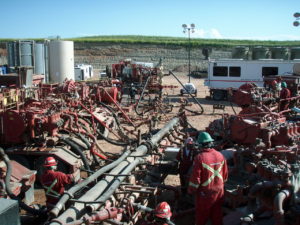Fracking 101
 I’ve consistently heard the word “fracking” thrown around when discussing environmental issues, but I never knew exactly what it meant. Since it’s a hot topic in the news lately, I thought it would be a good idea to outline the basics of this technique and explain its impact.
I’ve consistently heard the word “fracking” thrown around when discussing environmental issues, but I never knew exactly what it meant. Since it’s a hot topic in the news lately, I thought it would be a good idea to outline the basics of this technique and explain its impact.
Fracking is a procedure that recovers gas and oil from shale, which is a type of rock. It is executed by drilling into the earth and directing a high-pressure water mixture at the rock to release the gas trapped inside. Fracking allows the United States to obtain its own oil, and as a result, gas prices have gone down… The gas released also generates large amounts of electricity, and it’s safer to use than coal as it emits less carbon dioxide (CO2).
So if fracking has these positive effects, why are so many people against it? There are multiple environmental concerns when it comes to this energy harvesting tactic. Some worry that the chemicals used to break the rock below the earth’s surface might escape and contaminate groundwater near the site. Others are concerned that the procedure has a tendency to lead to small earth tremors, as small earthquakes have followed fracking in the past. Lastly, it has been argued that this reliance on fossil fuels is not a sustainable solution to our energy crisis.
The point of this post is not to convince you to choose a side on the fracking debate, but rather to raise awareness about the pros and cons of this controversial technique, so that you might feel prepared to engage in a discussion about it. Today’s youth will one day be making important decisions about issues that will impact our environment in the future, so it’s imperative that we know what we’re dealing with.
-Tess

